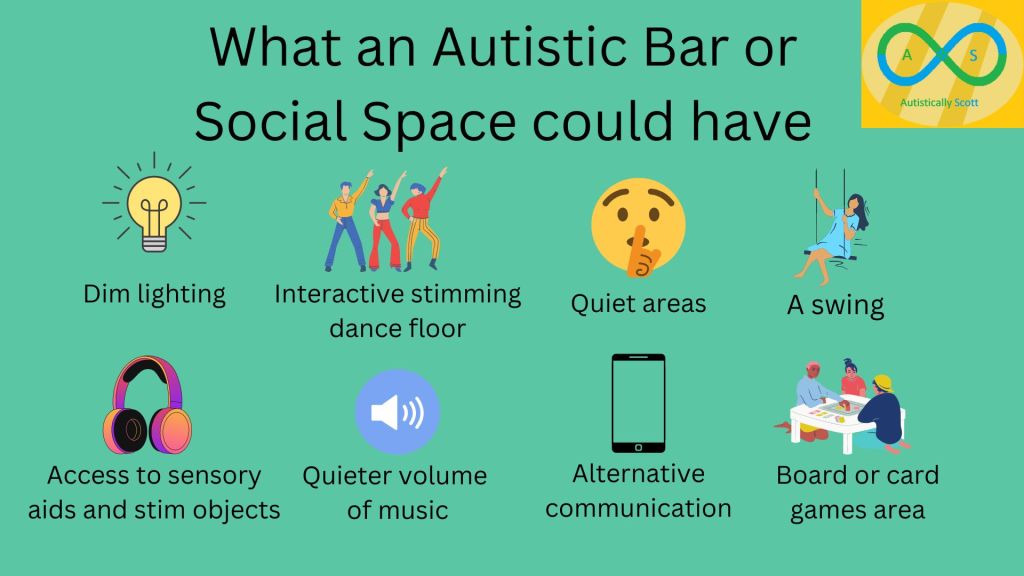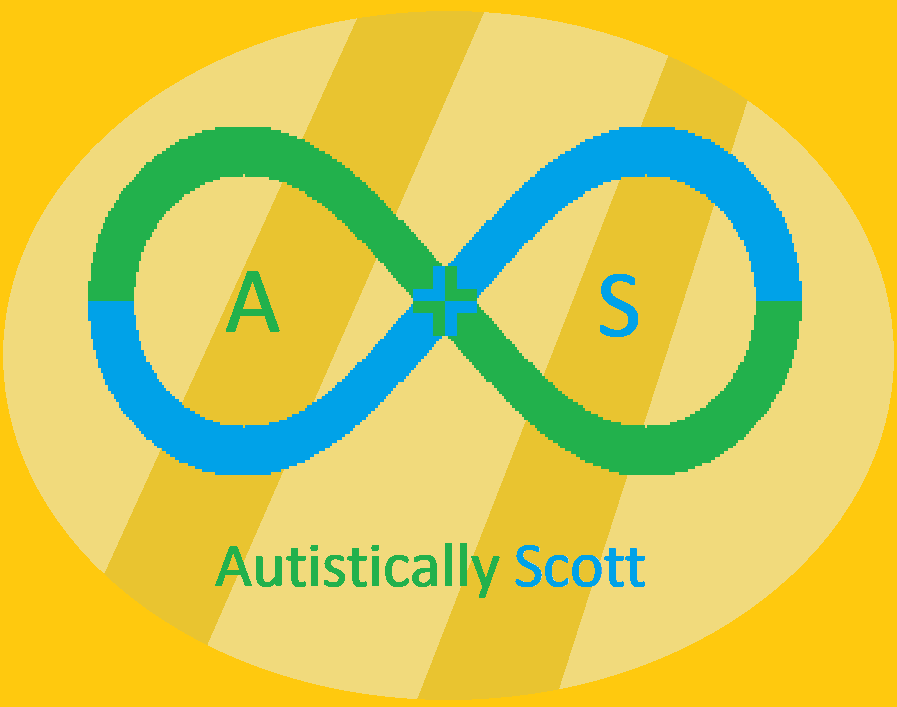Loud environments are settings that I’ve always struggled with. I remember as a child that I would hide under tables at restaurants and parties. One of the clears sign as a child that I was Autistic but I was not identified as this until years later. As a young adult, I started to join nights out & attend regular Christmas parties through groups or workplaces but the volume of music and crowds of people at these events all gets too much for me. In addition, many of these social spaces feel very warm, smell badly, have sticky floors and feature bright or frenetic lighting. I am also naturally an introvert and this bombardment of sensory and social information is draining. Therefore, it is difficult for me to last long in these environments or find much enjoyment from being in them. Neuronormative social spaces are not designed for Autistic and other Neurodivergent people and can actually be hostile to us.
In the past few weeks, I have been going out to pubs and bars with friends more frequently for the first time in nearly 3 years. This was enjoyable previously as we had a few places that were fairly relaxing on weekends & not too loud or intense as they were more family friendly. Last weekend, we decided to go to a new bar that we hadn’t visited before. I was up for this as I do have a desire to explore new places and put myself out there. Although struggling with change is often associated with Autistic people, I find that new experiences can be rewarding for me. Unfortunately upon entering this bar, a band was playing their live music at such a high volume and frequency that I instantly froze up inside. We sat down at the nearest table and it was impossible for me and my friends to communicate through speech. This was disappointing as I do want to connect to people and have conversations but environments like this render that practically unachievable.
On a bright side of this night, we did find a way to use AAC (augmentative and alternative communication) due to the level of noise. Since we could not hear each other, we communicated through memes in our group chat. It was mostly Marvel memes, which is one of our shared interests. This was a nice form of AAC and I feel it is an example of how AAC can benefit all Autistic people when we are in environments that are distressing or when we feel overloaded. Memes are a valid form of communication!
Still, it does upset me that there are such barriers like this for me in social settings. I want to be social and connect to people but the level of noise and other sensory input is often so overwhelming that you can’t hear or speak to anyone in meaningful ways. I have a pair of Loops earplugs (pictured below) which some Autistic people have mentioned helps them in social gatherings. So far, I have only used these to block out loud family members or annoying people, but I think I will utilise them more when I go out.

Following the night at the bar, I went online and listened to other Autistic people share their similar struggles with environments like I just experienced. It was nice for me to hear this as it reminds me I am not alone in how painful these environments can actually feel. One of the worst parts of being in such places is the internalised ableism that can build up. I can become extremely self-critical and harsh on myself after being in bars or events as I compare myself to other people and how much fun they are having. The aftermath can have me believing I am worthless or a loser for struggling to cope in spaces designed based on neurotypicality. I have always felt sensitive in the world and I can find myself stuck in ruts of guilt and shame following time in these spaces.
Over the years I’ve had my internal critic saying things such as this during or after social events:
“Why can’t you just deal with it?
“What is wrong with you?”
“You are worthless.”
“It’s not that loud in here.”
“Everyone else can go out and enjoy themselves.”
It can become a viscous cycle. Something that helps me during this is reflecting on my life and how much progress I have made. I have been able to maintain friendships and have had relationships over the years. I’m also in a place in my life now where I can deliver talks to dozens of people for hours, which requires a lot of socialising and energy. However, I find events like nights out or parties to be far more challenging than delivering those talks. It is not a lack of social skills, but a different way of being social and finding the right environments for me to flourish with this.
Being back in non-autistic spaces like the recent bar I attended makes me miss Autscape as that was an event designed for Autistic people. An event where we could enjoy things in silence or in calm areas. There were plenty of opportunities to socialise and meet other Autistic people, but unfortunately it only lasts for a few days before we are all sent back to the neurotypical-led world. Autscape also had a quiet disco one evening but I didn’t experience this as me and my friend went somewhere else during that night.
Maybe we could start to design more bars, parties and venues that are friendly social spaces for Autistic people? It is not enough to have a few tokenistic hours of “autism friendly” slots at supermarkets or cinemas. There are millions of Autistic adults and many of us want to socialise but can’t due to how disabling most of what is considered ‘social spaces’ can be for us. I believe we Autistic people need to come together and build our own networks and spaces. We can take inspiration from the LGBTQ+ community in how they have designed their own bars and social gatherings too. Autscape has given me a new outlook and vision on what Autistic spaces are like and that it is possible for us to build more of these around the world.
An Autistic designed bar or social space could have dim lighting, stimmy visuals and objects. It could have quiet areas and lower volumes of music or calm ambient music playing. Bars and social gatherings such as this could allow us to feel safe enough to unmask. Of course, every Autistic person is different and some can absolutely enjoy these loud & busy environments as they may be more sensory seeking with this input. Unfortunately a lot of us are easily overwhelmed by these kinds of spaces.
Despite what the dominant narrative and media makes people believe, a lot of Autistic people do want to connect and be social. We just might need to do this in different ways. Having bars and social venues more adjusted to our needs could help us meet people and socialise. Even the most introverted of us Autistic people have social needs too.
I’ve made up some ideas for what a bar or social space designed by and for Autistic people could be like. What would you include in a bar or social space for Autistic people?


Leave a comment